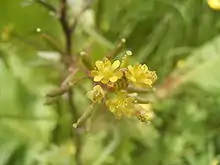Rorippa palustris
Rorippa palustris, marsh yellow cress, is a species of flowering plant in the family Brassicaceae. It is widespread and native to parts of Africa, and much of Asia, Europe and Eurasia, North America and the Caribbean.[1] It can also be found in other parts of the world as an introduced species and a common weed, for example, in Australia and South America.[1] It is an adaptable plant which grows in many types of damp, wet, and aquatic habitat. It may be an annual, biennial, or perennial plant, and is variable in appearance as well.
| Rorippa palustris | |
|---|---|
 | |
| Scientific classification | |
| Kingdom: | Plantae |
| Clade: | Tracheophytes |
| Clade: | Angiosperms |
| Clade: | Eudicots |
| Clade: | Rosids |
| Order: | Brassicales |
| Family: | Brassicaceae |
| Genus: | Rorippa |
| Species: | R. palustris |
| Binomial name | |
| Rorippa palustris | |
| Synonyms[1][2] | |
Description
It produces an erect stem, sometimes with branches, attaining a maximum height of just over one meter. The leaves are up to 30 centimeters long and have toothed to deeply lobed edges. The inflorescence is a raceme of mustardlike flowers with spoon-shaped yellow petals each a few millimeters in length. The fruit is a dehiscent and smoothly valved silicle, up to a centimeter long, and containing anywhere from 20 to 90 minute seeds.[3]
Etymology
The species epithet palustris is Latin for "of the marsh" and indicates its common habitat.[4]
Common names
In botanical literature, Rorippa palustris has been called by numerous common names (with variations). Some of them are listed here:
Distribution
Rorippa palustris is native to, or naturalized across much of the globe.[1]
Native range
- AFRICA:[1] in Egypt and Ethiopia.
- ASIA and EURASIA:[1] in Afghanistan; Bhutan; the Caucasus (in Armenia, Azerbaijan, Georgia, and Russia) and Ciscaucasia (in Dagestan); much of China and Taiwan; India (in the states of Assam, Bihar, Himachal Pradesh, Jammu and Kashmir, and West Bengal); Indonesia (in Papua province, Java, the Lesser Sunda, and Maluku Islands); Japan (in the prefectures of Hokkaido, Honshu, Kyushu, Shikoku, and the Ryukyu Islands); Kazakhstan; the Korean Peninsula; Kyrgyzstan; Mongolia; Pakistan; Papua New Guinea; eastern and western Siberia; Tajikistan; northeastern Turkey; Turkmenistan; Uzbekistan; and Yemen.
- EUROPE:[1] grows natively in most regions.
- NORTH AMERICA:[5] in every province and territory (excluding Nunavut) of Canada; Puerto Rico; the District of Columbia and every state (excluding Hawaii) in the United States; Mexico
- The CARIBBEAN:[1] in Cuba and Haiti.
- AUSTRALASIA:[1] New Zealand[7]
References
- Under its currently accepted name of Rorippa palustris (from its basionym Sisymbrium amphibium var. palustre) this taxon was published in Enumeratio Plantarum 27, 103. 1821. "Rorippa palustris". Germplasm Resources Information Network. Agricultural Research Service, United States Department of Agriculture. Retrieved 14 July 2013.
- Sisymbrium amphibium var. palustre (the basionym of Rorippa palustris) was first described and published in Species Plantarum 2:657. 1753. "Sisymbrium amphibium var. palustre". Germplasm Resources Information Network. Agricultural Research Service, United States Department of Agriculture. Retrieved 14 July 2013.
- Reed C. Rollins (2012). "Key to Rorippa yellow cress". Jepson eFlora. Berkeley, CA: University of California Press. Retrieved 14 July 2013.
- Archibald William Smith A Gardener's Handbook of Plant Names: Their Meanings and Origins, p. 258, at Google Books
- "Profile for Rorippa palustris (bog yellowcress)". PLANTS Database. USDA, NRCS. Retrieved 14 July 2013.
- BSBI List 2007 (xls). Botanical Society of Britain and Ireland. Archived from the original (xls) on 2015-06-26. Retrieved 2014-10-17.
- De Lange, P.J.; Heenan, P.B.; Townsend, A.J. (2009). "Rorippa laciniata (Brassicaceae), a new addition to the flora of New Zealand". New Zealand Journal of Botany. 47 (2): 133–137. doi:10.1080/00288250909509800. S2CID 83609780.